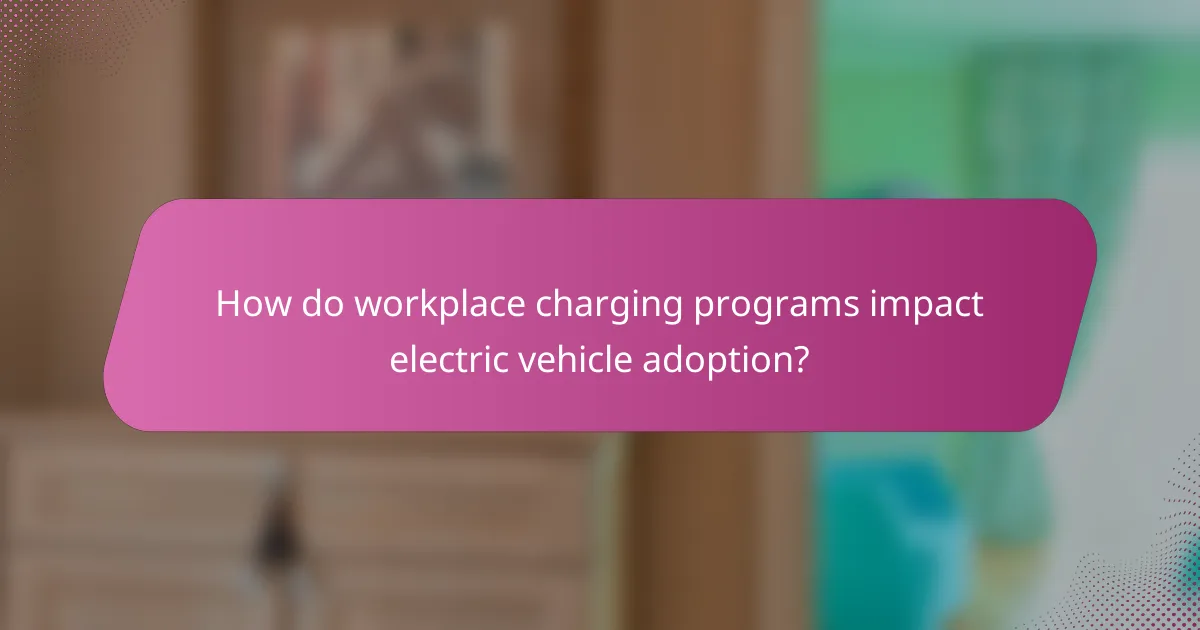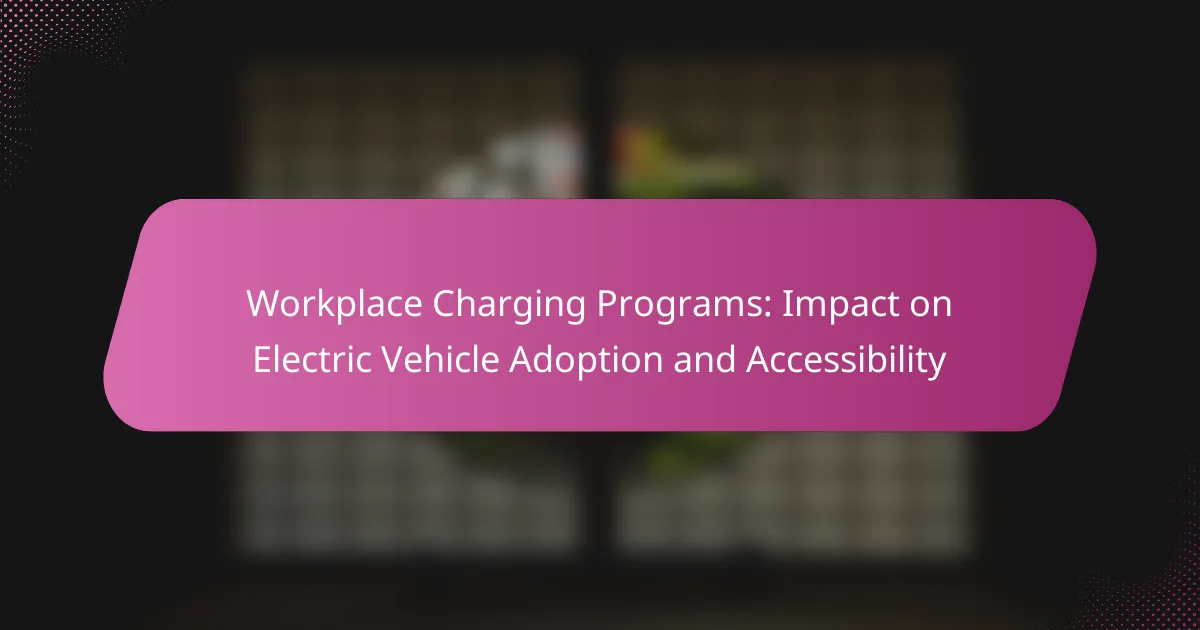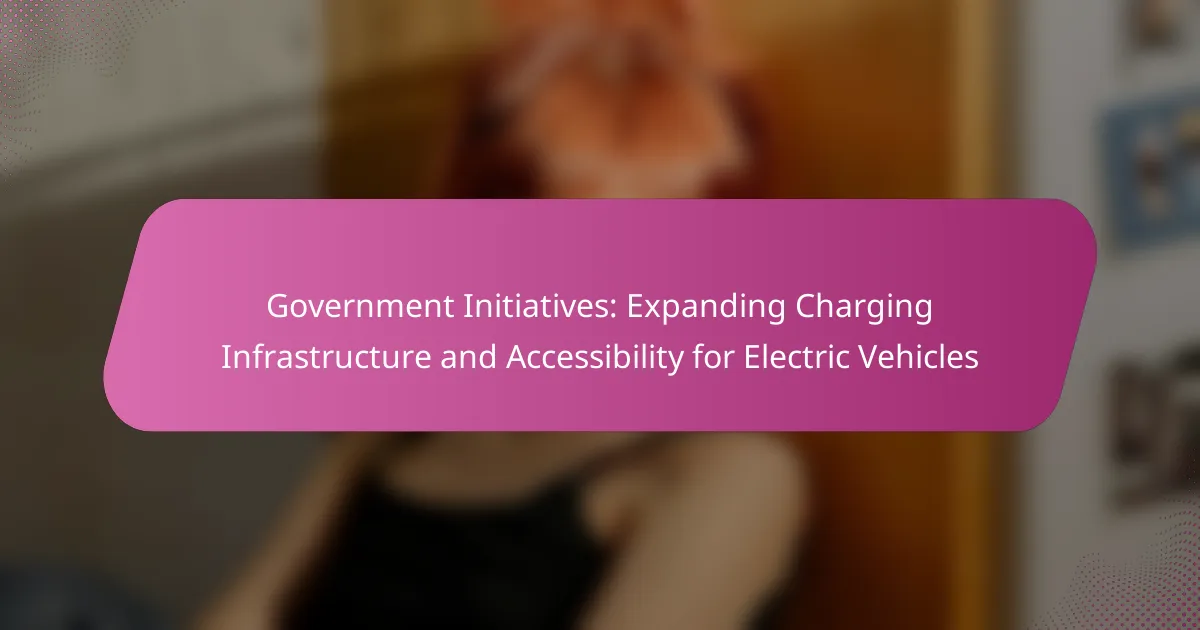Workplace charging programs play a crucial role in promoting electric vehicle (EV) adoption by offering employees easy access to charging stations during their workday. This convenience not only encourages more individuals to consider EVs as a practical transportation option but also enhances employee satisfaction and retention, contributing to a more sustainable workplace. By fostering partnerships and providing financial incentives, organizations can create an environment that supports the transition to electric mobility.

How do workplace charging programs impact electric vehicle adoption?
Workplace charging programs significantly enhance electric vehicle (EV) adoption by providing employees with convenient access to charging stations during work hours. This accessibility encourages more individuals to consider EVs as a viable option for their transportation needs.
Increased accessibility for employees
Workplace charging stations make it easier for employees to charge their EVs, especially for those who may not have access to home charging. This increased accessibility can lead to higher EV ownership rates among employees, as they feel more confident in their ability to keep their vehicles charged throughout the day.
Employers can consider installing charging stations in various locations, such as parking garages or lots, to maximize convenience. Offering charging options can also serve as an attractive perk for potential hires, enhancing the company’s appeal in a competitive job market.
Enhanced convenience for EV owners
Having charging facilities at work allows EV owners to charge their vehicles during the day, reducing the need for home charging infrastructure. This convenience can alleviate range anxiety, as employees can ensure their vehicles are charged while they work, making EVs a more practical choice.
Employers can implement flexible charging schedules or reservation systems to manage usage effectively. This can help ensure that charging spots are available when employees need them, further enhancing the convenience of owning an EV.
Boost in corporate sustainability initiatives
Workplace charging programs align with corporate sustainability goals by promoting the use of cleaner transportation options. By encouraging employees to drive EVs, companies can reduce their overall carbon footprint and contribute to environmental conservation efforts.
Additionally, businesses can leverage their charging programs in marketing and public relations efforts, showcasing their commitment to sustainability. This can enhance brand reputation and attract environmentally conscious consumers and clients.

What are the benefits of implementing workplace charging stations?
Implementing workplace charging stations offers significant advantages, including enhanced employee attraction and retention, a reduced carbon footprint, and improved overall satisfaction among staff. These benefits contribute to a more sustainable and appealing work environment, making electric vehicle (EV) adoption more accessible for employees.
Attracting and retaining talent
Workplace charging stations can be a key factor in attracting and retaining talent, particularly among environmentally conscious employees. Companies that offer EV charging demonstrate a commitment to sustainability, which can enhance their reputation and appeal to potential hires.
Moreover, providing charging facilities can differentiate an employer in competitive job markets. Employees are more likely to stay with organizations that support their lifestyle choices, including the use of electric vehicles.
Reducing carbon footprint
By facilitating the use of electric vehicles, workplace charging stations contribute to a significant reduction in a company’s carbon footprint. This aligns with global efforts to combat climate change and can enhance corporate social responsibility initiatives.
Employers can also benefit from potential tax incentives or rebates for installing EV charging infrastructure, which can offset initial costs. Investing in sustainable practices not only helps the environment but can also lead to long-term financial savings.
Improving employee satisfaction
Access to charging stations at work can greatly enhance employee satisfaction by providing convenience and reducing range anxiety associated with electric vehicles. Employees appreciate the ability to charge their vehicles during work hours, making it easier for them to transition to EVs.
Additionally, companies that prioritize sustainability and employee needs often see higher morale and productivity. A supportive workplace culture that includes EV charging can lead to a more engaged and motivated workforce.

What factors influence the success of workplace charging programs?
The success of workplace charging programs largely depends on employee engagement, financial incentives, and partnerships with charging network providers. These elements work together to create an environment that encourages electric vehicle (EV) adoption and makes charging accessible for employees.
Employee engagement and awareness
Employee engagement is crucial for the effectiveness of workplace charging programs. When employees are informed about the benefits of EVs and the availability of charging stations, they are more likely to consider switching to electric vehicles.
Employers can enhance engagement through informational sessions, newsletters, or workshops that highlight the advantages of EVs, such as cost savings and environmental benefits. Regular communication can keep the topic relevant and encourage participation.
Availability of incentives and subsidies
Financial incentives and subsidies can significantly impact the adoption of workplace charging programs. Employers can offer perks such as reduced charging fees, rebates for EV purchases, or even tax incentives to make the transition more appealing.
In the United States, for example, federal tax credits may cover a portion of the costs associated with installing charging infrastructure. Employers should explore local and national programs to maximize financial support for their initiatives.
Partnerships with charging network providers
Forming partnerships with charging network providers can enhance the accessibility and reliability of workplace charging stations. Collaborating with established networks ensures that employees have access to a wider range of charging options, both at work and in the community.
Employers should consider integrating their workplace charging solutions with popular charging networks, which can facilitate easier payment options and real-time availability updates. This approach not only improves user experience but also encourages more employees to adopt electric vehicles.

How do different companies implement charging solutions?
Companies implement charging solutions through various strategies, including installing charging stations on-site, partnering with charging networks, and providing incentives for employees to adopt electric vehicles (EVs). These approaches can enhance EV accessibility and support sustainability goals while catering to the specific needs of their workforce.
Case study: Google’s EV charging infrastructure
Google has developed an extensive EV charging infrastructure across its campuses, featuring hundreds of charging stations available for employees. The company focuses on integrating charging solutions into its workplace environment to encourage EV adoption among staff.
Google’s approach includes offering free charging, which significantly reduces the cost barrier for employees considering an electric vehicle. Additionally, the company has implemented a user-friendly app that allows employees to locate available charging stations easily.
Case study: Tesla’s workplace charging initiatives
Tesla has established workplace charging initiatives that align with its mission to accelerate the world’s transition to sustainable energy. The company provides Supercharger stations at various corporate locations, allowing employees to charge their vehicles quickly during work hours.
By offering incentives such as reduced electricity costs for charging at work, Tesla encourages its employees to drive electric vehicles. This initiative not only supports the company’s sustainability goals but also enhances employee satisfaction and retention.
Case study: Amazon’s commitment to EV accessibility
Amazon is committed to improving EV accessibility through its workplace charging programs, which include installing charging stations at fulfillment centers and corporate offices. The company aims to create a robust network of charging solutions that cater to its diverse workforce.
Amazon’s strategy includes partnerships with local charging networks to expand access beyond its facilities. By providing incentives for employees to switch to electric vehicles, Amazon is actively contributing to the reduction of carbon emissions and promoting a greener future.

What are the challenges of workplace charging programs?
Workplace charging programs face several challenges that can hinder their effectiveness in promoting electric vehicle (EV) adoption. Key issues include high installation costs, limited space for charging stations, and the need to manage energy consumption efficiently.
High installation costs
The initial investment for installing charging stations can be substantial, often ranging from several thousand to tens of thousands of dollars depending on the number of stations and infrastructure upgrades needed. Organizations must consider not only the cost of the charging units but also electrical upgrades, labor, and potential permitting fees.
To mitigate these costs, businesses can explore partnerships with EV charging companies that may offer financing options or incentives. Additionally, some local governments provide grants or tax credits to encourage the adoption of EV infrastructure, which can significantly reduce upfront expenses.
Limited space for charging stations
Many workplaces may struggle with space constraints, especially in urban areas where parking is limited. Finding suitable locations for charging stations that do not disrupt existing operations or parking layouts can be challenging.
Employers should assess their current parking facilities and consider options such as installing charging stations in underutilized areas or integrating them into new construction plans. Prioritizing charging stations for employees who drive EVs can also help maximize the use of available space.
Managing energy consumption
Workplace charging programs must effectively manage energy consumption to avoid overloading electrical systems, especially during peak usage times. This requires careful planning and potentially the installation of smart charging solutions that can optimize energy use based on demand and availability.
Employers can implement strategies such as scheduling charging times during off-peak hours or utilizing demand response programs that adjust charging rates based on grid conditions. Monitoring energy consumption and adjusting policies accordingly can help maintain efficiency and reduce costs associated with energy use.

How do workplace charging programs compare to public charging stations?
Workplace charging programs typically offer more convenience and accessibility for electric vehicle (EV) users compared to public charging stations. They provide employees with the opportunity to charge their vehicles during work hours, often at no cost, which can encourage greater EV adoption.
Convenience for employees
Workplace charging stations are strategically located where employees spend a significant portion of their day, making it easier for them to charge their vehicles while they work. This eliminates the need to make special trips to public charging stations, which can be less convenient and often require waiting in line.
Additionally, having charging options at work can alleviate range anxiety for employees, as they can start their commute home with a fully charged vehicle. Many companies offer charging during work hours, allowing employees to plug in their cars and focus on their tasks without worrying about their vehicle’s battery level.
Cost-effectiveness for companies
Implementing workplace charging programs can be a cost-effective strategy for companies looking to support sustainability initiatives. The initial investment in charging infrastructure can often be offset by incentives, tax credits, and reduced fuel costs for employees who switch to electric vehicles.
Furthermore, offering charging stations can enhance employee satisfaction and retention, as many workers value environmentally friendly practices. Companies may also find that providing charging options can attract talent, especially in regions where EV adoption is on the rise.



